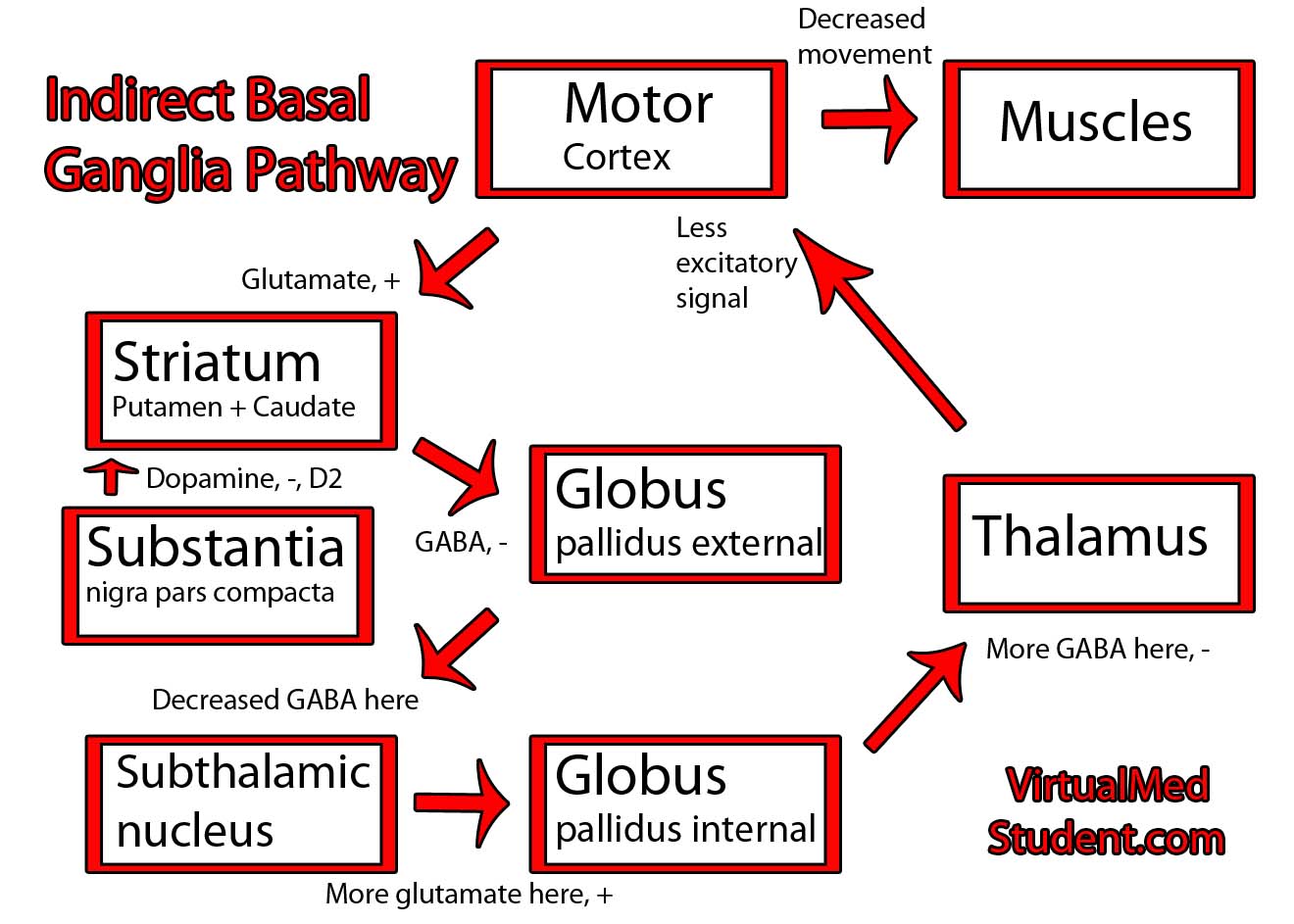The basal ganglia represent a system of several discrete collections of neurons within the brain. These collections of neurons interact closely with the part of the cerebral cortex that initiates movement. The basal ganglia fine tune the starting and stopping of movements.
The term "basal ganglia" encompasses several separate, but interrelated neuron populations. The putamen, caudate, globus pallidus internus (GPi), globus pallidus externus (GPe), substantia nigra (SN), and subthalamic nucleus (STN) are all discrete neuron populations that, as a whole, compose the "basal ganglia". These named populations of neurons work together to achieve a common goal. The term "striatum" includes the caudate and putamen only, and the term "lentiform nuclei" includes the putamen and globus pallidus.
The basal ganglia modulate movement through a complex loop of both inhibitory and excitatory signals. When you decide to move, your frontal lobes send an excitatory signal via the neurotransmitter glutamate to the striatum (FYI: striatum = caudate and putamen).
In the indirect basal ganglia pathway the striatum then sends an inhibitory signal via the neurotransmitter GABA to the external segment of the globus pallidus. This is different from the direct pathway where the striatum sends a signal to the internal segment of the globus pallidus.
The external segment of the globus pallidus normally indirectly (more on this in the next few paragraphs) inhibits its internal counterpart. Thus, when the striatum inhibits the external segment, it is, in effect, releasing the internal segment from inhibition (that sure seems like a lot of double negatives!).
At this point, the internal segment of the globus pallidus is able to send its inhibitory signals to the thalamus, which causes thalamic neurons to stop sending excitatory signals to the motor cortex. The cortex is then unable to send an impulse down the spinal cord and, ta-da, the net result is a decrease in movement.
It would be easier to understand if the external segment of the globus pallidus “talked” directly to the internal segment, but that is not how it works. The message is relayed through another nucleus known as the subthalamic nucleus.
The subthalamic nucleus is usually inhibited by the external segment of the globus pallidus. Therefore, when the striatum inhibits the external globus pallidus, it causes the cells in the subthalamic nucleus to become more active (ie: the subthalamic nucleus is released from the inhibitory effects of the external globus pallidus).
The subthalamic nucleus, in turn, is able to send an excitatory signal to the neurons in the internal segment of the globus pallidus. The cells in GPi then become more active, which means that they suppress the activity of the thalamus more robustly. The thalamus is then unable to send its normal excitatory messages to the motor cortex. End result? Decreased movement!

So how does dopamine act on the indirect pathway? Dopamine is secreted by the substantia nigra and binds to D2 receptors (these are different than the D1 receptors of the direct pathway) in the striatum. This causes striatal neurons to decrease their inhibitory message to the external segment of the globus pallidus. The external segment of the globus pallidus is then free to carry out its “normal” job and suppress the excitatory actions of the subthalamic nucleus on its internal counterpart. Less excitation going to the internal globus pallidus translates to less inhibition of the thalamus, and ultimately more excitation of the cortex!
Therefore, if you’ve managed to work through these complicated systems, you’ll realize that dopamine causes increased movement by activating the direct pathway and inhibiting the indirect pathway.
Overall, the indirect basal ganglia pathway has the exact opposite effect of the direct pathway. The indirect pathway serves as a negative modulator of movement and the direct pathway serves as a positive modulator of movement. Now that is some complicated sh**t!
Importance in Disease
Diseases of the basal ganglia cause unwanted movements, or a failure to initiate movement.
The classic basal ganglia disease is Parkinson’s disease, which has elements of both unwanted movement (resting tremor) and difficulty initiating movement (bradykinesia). Other diseases such as hemiballismus, in which the affected person violently flings an extremity, can occur when there is damage to the subthalamic nucleus.
Additionally, in Huntington’s disease the GABA and enkephalin projections from the caudate nucleus to the external globus pallidus are affected. This is believed to be responsible for many of the movement abnormalities seen in patients with this disease.
Overview
The indirect basal ganglia pathway fine tunes motor movements. It involves both excitatory and inhibitory signals through the striatum, globus pallidus, substantia nigra, thalamus, and motor cortex. Diseases such as Parkinson’s disease, hemiballismus, and Huntington’s disease may occur when there is damage to one of the components of the basal ganglia.
References and Resources
- Baehr M, Frotscher M. Fourth Edition. Stuttgart: Thieme, 2005.
- Bickley LS, Szilagyi PG. Bates’ Guide to Physical Examination and History Taking. Ninth Edition. New York: Lippincott Williams and Wilkins, 2007.
- Nolte J. The Human Brain: An Introduction to its Functional Anatomy. Sixth Edition. Philadelphia: Mosby, 2008.
- Purves D, Augustine GJ, Fitzpatrick D, et al. Neuroscience. Fourth Edition. Sinauer Associates, Inc., 2007.
Related Articles